#empress elizabeth of russia
Explore tagged Tumblr posts
Text










Women’s History Meme || Empresses (4/5) ↬ Empress Yelisaveta Petrovna of Russia (1709 – 1762)
Yet Elizabeth’s flighty persona was a concoction to help her survive in a scorpions’ nest. While vaunting her numerous love affairs, she carefully concealed her political acumen. The British envoy’s wife reported, “In public she has an unaffected gaiety, and a certain air of giddiness that seems entirely to possess her whole mind… In private I have heard her talk with such a strain of good sense and steady reasoning that I am persuaded the other behavior is a feint.” … Numerous powerful families tried to persuade Elizabeth to stage a coup and proclaim herself empress. Afraid of bloodshed, Elizabeth hesitated until she heard rumors that Anna Leopoldovna was planning on claiming the imperial crown for herself and having her inconvenient cousin shut up in a convent. Elizabeth shuddered at the thought of religious life because, as one contemporary wrote, there was “not an ounce of nun’s flesh about her.” On November 25, 1741, hours before she was to be arrested, Elizabeth rallied loyal troops and invaded the palace. The coup was ridiculously easy; the people wanted the daughter of Peter the Great to rule. Anna was imprisoned in one fortress and her infant son in another. Elizabeth was gentle with her former enemies who now swarmed to proclaim their loyalty. She swore never to sentence anyone to death for political crimes. She outlawed the torture of children under seventeen and the cutting off of women’s noses. Even the humblest subjects were encouraged to hand Elizabeth petitions for redressing injustice. Unlike her three female predecessors—her mother, Catherine I; Empress Anna; and the regent Anna Leopoldovna—Elizabeth took her governmental responsibilities quite seriously, working most of the day, reading reports, presiding over meetings, forcing rival ministers to make peace. Mercurial and temperamental, Elizabeth had an arsenal of tactics to get her way—flashing a brilliant smile, stamping her foot in impatience, swearing like a fishwife, complimenting and cajoling. — Sex With the Queen: 900 Years of Vile Kings, Virile Lovers, and Passionate Politics by Eleanor Herman
#women's history meme#empress elizabeth of russia#house of romanov#russian history#european history#women's history#history#nanshe's graphics
39 notes
·
View notes
Text
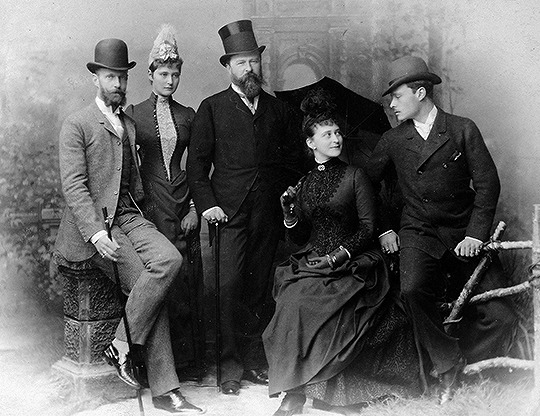
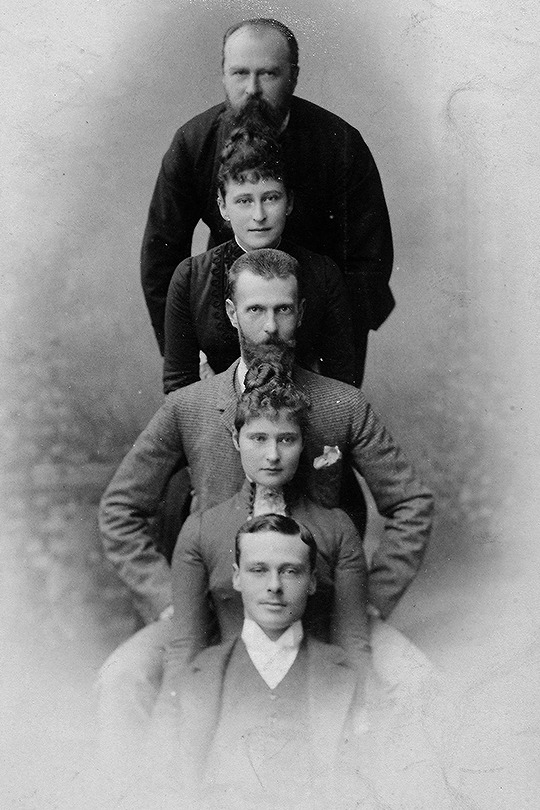
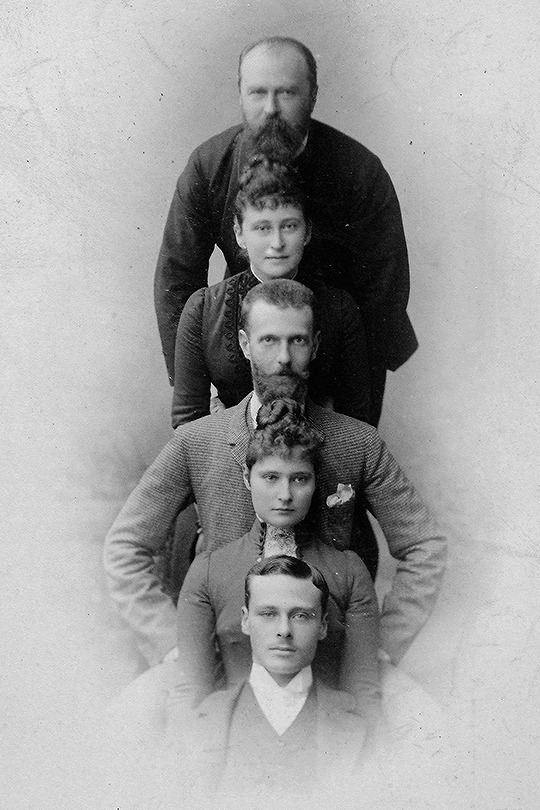

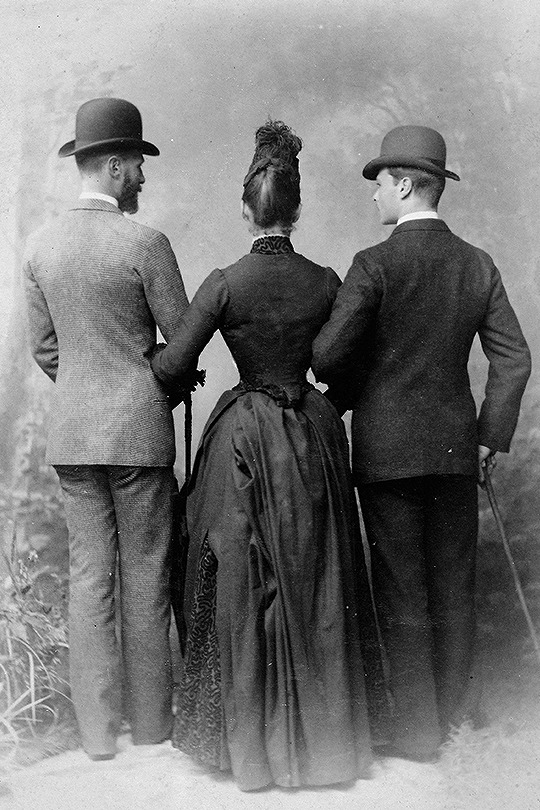
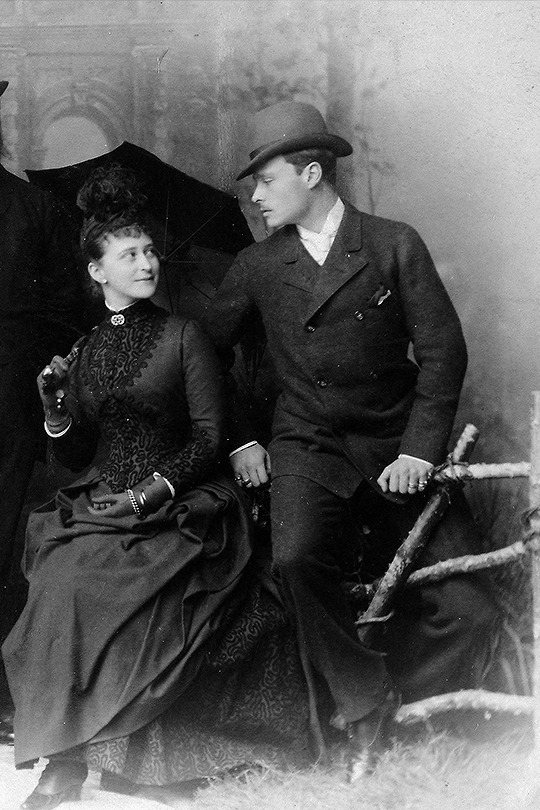
Grand Duke Sergei Alexandrovich, Princess Alix of Hesse, Grand Duke Louis IV, Grand Duchess Elizabeth Feodorovna, Prince Ernest Louis, 1888.
#grand duchess elizabeth feodorovna#romanov#empress alexandra feodorovna#grand duke serge alexandrovich#louis iv#ernest louis grand duke of hesse#hesse#russia#the last pic!! :')
179 notes
·
View notes
Text

Grand Duke Louis IV of Hesse with his surviving children: Princess Victoria of Battenberg, Marchioness of Milford-Haven, Grand Duchess Elizabeth Feodorovna of Russia, Princess Irene of Prussia, Empress Alexandra Feodorovna of Russia and Grand Duke Ernest Louis of Hesse, 1884.
#Grand Duke Louis IV of Hesse#grand duke ludwig iv of hesse#Princess Victoria of Battenberg#princess victoria marchioness of milford haven#Grand Duchess Elizabeth Feodorovna of Russia#Grand Duchess Elizabeth Feodorovna#Grand Duchess elizabeth of russia#empress alexandra feodorovna of russia#empress alexandra feodorovna#empress alexandra of russia#Princess Irene of Prussia#princess henry of prussia#Grand Duke Ernest Louis of Hesse#princess alix of hesse#princess victoria of hesse#princess irene of hesse#princess elizabeth of hesse#1880s#1884#imperial russia#imperial family#russian imperial family#romanovs#victorian#colored photography#british royal family#german royalty#1880s fashion#history colored
83 notes
·
View notes
Video
Louis IV, Grand Duke of Hesse with his daughters Elizabeth and Alix and son Ernest. St-Petersburg. 1888. by Tatiana Zakharova Via Flickr:
#BW#Darmstadt#Duchess#Elizabeth#Grand Duchess#Grand Duke#Hesse-Darmstadt#Hessen#HIstorical#Photography#PHOTOS#Princess#Princess Elizabeth#Romanov#Royal#Royalty#Russia#vintage#|Empress Alexandra Feodorovna#History#Alix of Hesse#flickr
14 notes
·
View notes
Text
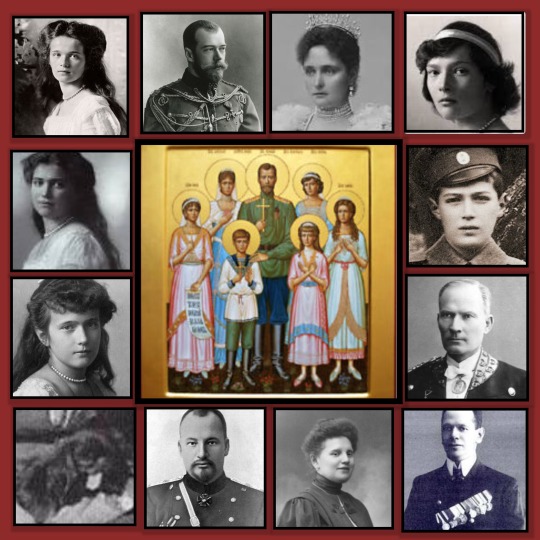
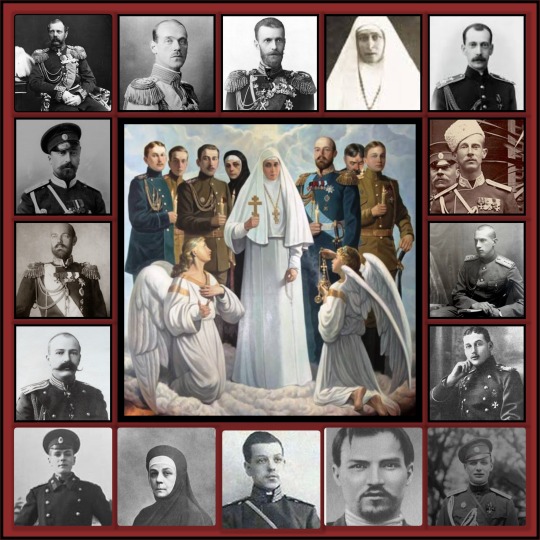
The Romanov Martyrs
I wanted to put together a little memorial that included all the members of the Romanov Family (as well as the members of their staff) that were murdered by the Bolshevik terrorists. This seems like a good week to keep them in our minds. Although we love and mourn the children especially, there were others we cannot forget.
Tsar Alexandre II was hunted down until finally blown to pieces.
Dowager Empress Maria Feodorovna lost two sons and five grandchildren (no wonder she could not accept they were dead)
Grand Duke Sergei Alexandrovich was also hunted down and blown to pieces
Three Mikhailovichi brothers were murdered
Four Konstantinovichi were murdered, three of them brothers; I cannot imagine what their mother, Grand Duchess Elizabeth Mavrikievna, went through...and so on.
May they rest in peace.
#russian history#imperial russia#romanov family#Nicholas II#Tsar Alexander II#Empress Alexandra Feodorovna#Grand Duchess Elizabeth Feodorovna#OTMAA#Grand Duke Mikhail Alexandrovich#Grand Duke Sergei Alexandrovich#Grand Duke Pavel Alexandrovich#Grand Duke Nicholas Mikhailovich#Grand Duke Georgiy Mikhailovich#Grand Duke Sergei Mikhailovich#Grand Duke Dmitry Konstantinovich#Prince Ioann Konstantinovich#Prince Igor Konstantinovich#Prince Konstantin Konstantinovich#Dr. Eugene Botkin#Anna Demidova#ivan karitonov#Akexei Trupp#Sister Varvara Yakolevna#Feodor Remez#mr. johnson
75 notes
·
View notes
Text










Tsarinas Consorts of Russia {12/16}: Elizabeth Alexeievna (born Princess Louise of Baden).
"Elizabeth Alexeievna was distinguished by a soft, melodious voice and a beautiful oval face with delicate features; a Greek profile, large almond-shaped blue eyes and curly ash blond hair, which she usually left floating on her shoulders. With an elegant figure, regal carriage, and a beautiful angelic face, she was regarded by contemporaries as one of the most beautiful women in Europe and probably the most beautiful consort at that time. Charming, generous and intellectual, Elizabeth Alexeievna loved literature and the arts. She took music lessons from Ludwig-Wilhelm Tepper de Ferguson. Unfortunately, she possessed a shy, withdrawn personality which failed to endear her to either the Russian court or her in-laws. She preferred simplicity and solitude to the pomp and ceremony of life at court."
Wikipedia, the free encyclopedia
(movie: Emma - 2020)
7 notes
·
View notes
Text
The Great (Hulu) season 3 just came out and we haven't finished watching it YET, but we need to talk about how incredible Catherine and Peter's love is.
Like come on, Peter is an indefensibly horrible man who has done some incredibly unforgivable things (we are still crying over Leo, plus fucking Catherine's mom to dead is batshit), but.....we just can't stop rooting for him and Catherine to somehow get their happily ever after. Is it insane? Yes. Are we planning on changing? No
It's wonderful that Catherine went through with stabbing Peter at the end of season 2 (she thought it was him which is what counts), because even though she lives him with all her heart, she's still trying to make rational decisions
(Season 3 spoilers in this paragraph) Even things like him refusing to kill the man who assaulted him as a child because Catherine didn't want to (he only slipped up after Simitz taunted Grigor), and the fact that he doesn't want to sleep with anyone other than Catherine anymore is so much evidence of his growth!!!
Anyway, the point is that their chemistry is incredible and I am rooting for them till my dying breath! What do you think? Watch out video and let us know!!
youtube
#the great hulu#the great amazon prime videos#catherine the great#peter the great#catherine x peter#orlo#Velementov#grigor x marial#grigor x George#Russia#Empress of Russia#nicholas hoult#elle fanning#orlo dead#podcast#youtube#aunt Elizabeth#archie#archie x marial
41 notes
·
View notes
Text

Louis Caravaque (French, 1684–1754) • Portrait of Elizabeth of Russia • 1750 • State Tretyakov Gallery, Moscow
Definitely over-dressed but we can forgive her for it, as she banned executions. She never married and was a proponent of sexual freedom. Kudos, Elizabeth!
The outrageous, extravagant, humorous, and often beautiful outfits worn by subjects of old portraits.
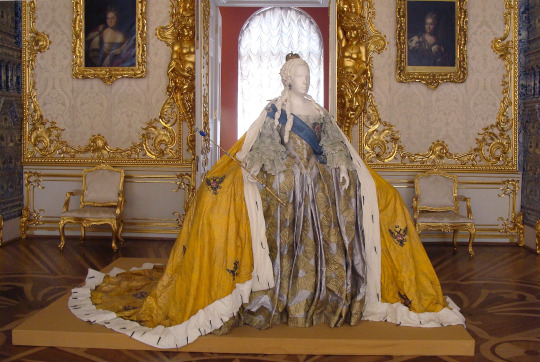
The ceremonial attire of Elizabeth • Catherine Palace, Museum Tsarskoye Selo
#painting#portrait#royal portraits#art#french artist#elizabeth of russia#historical portraits#the resplendent outfit#18th century art#fashion history#art history#empress of russia
13 notes
·
View notes
Text
Elizabeth Alexeievna (Russian: Елизавета Алексеевна; 24 January [O.S. 13 January] 1779 – 16 May [O.S. 4 May] 1826), born Princess Louise of Baden (German: Luise Marie Auguste von Baden), was Empress of Russia during her marriage to Emperor Alexander I. Via Wikipedia | @abwwia

Elisabeth Louise Vigée-LeBrun (1755-1842)
Portrait of Elizabeth Alekseevna (1779–1826), wife of Tsar Alexander I, after 1795
oil on canvas, h. 79 cm, w. 64,5 cm
National Museum in Warsaw
#Elizabeth Alexeievna#elisabeth louise vigée-lebrun#art by women#art#palianshow#women's art#art herstory#herstory#Empress of Russia#russian
6 notes
·
View notes
Note
Give me the name of every movie/documentary/things like that that has Alexander on it. Please😄
Warning: most are in Russian, good luck if you don't speak Russian
ok I'm not a big movie guy, so bare with me.
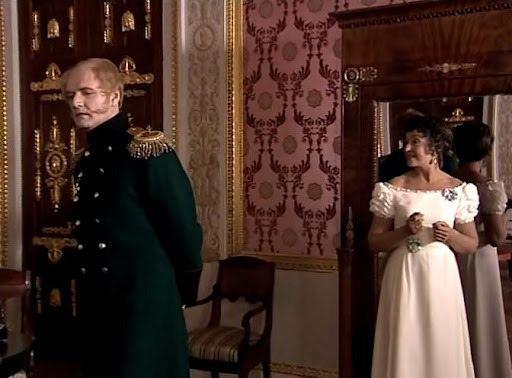
NORTHERN SPHINX
(Северный сфинкс) (2003)
Based on the novel of the same name by P. Gnedich.
About dramatic events in the fate of the Russian Emperor Alexander I. It was a time of mystical movements, Masonic lodges, the Holy Alliance, the Patriotic War of 1812, the Decembrists, Pushkin and the heyday of Russian poetry.
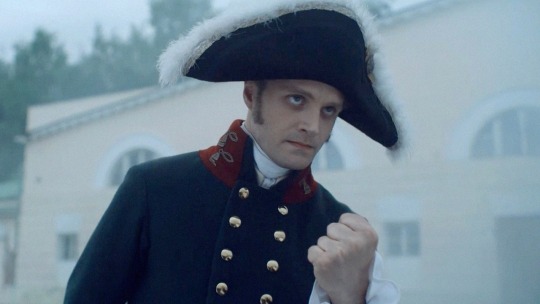
EMPIRE: ALEXANDER I
(Империя: Александр I) (2024)
The two-part film "Alexander I" is the fifth part of the documentary-fiction cycle "Empire", telling about the key historical events that shaped the path of the Russian Empire.
Having come to power as a result of a palace coup, Alexander I dreamed of a political reorganization of Russian society, and perhaps, if not for the opposition of the conservative nobility, Alexander's reforms could have significantly influenced the state structure. However, as we know, history does not require the subjunctive mood, and Alexander Pavlovich was destined for a completely different, much more important role.
He forever inscribed himself in history as the conqueror of Napoleon Bonaparte, a far-sighted strategist and diplomat, a loyal and loving son of his Fatherland.

ALEXANDER I
(Александр I) (2024)
Raised by his grandmother, Empress Catherine II, who saw in her eldest grandson the direct heir to the throne, and the European teacher Lagarp, Alexander adheres to liberal views and admires the first years of Napoleon's rule: he dreams that Russia will one day have a republic.
After Catherine's death, during the reign of Paul I, Alexander continued to hope for reform. However, he soon becomes disillusioned with Pavel both as a father and as a statesman. As a result of the conspiracy, Emperor Paul I is killed, and Alexander, haunted by guilt over his father's death, is forced to ascend the throne in order to resist the new intrigues of the aristocrats and his domineering mother. At the same time, Alexander understands that Russia is under threat: war with the invincible Napoleon is inevitable, it's only a matter of time.

DANCING ON GRAVES
(Tanssi yli hautojen) (1950)
In the early 1800s, Finnish governor's daughter first detests but soon falls in love with Russian Czar Alexander I who has just taken Finland over from Sweden's rule.

THE INVISIBLE TRAVELER
(Незримый путешественник) (1998)
The film tells about the everyday life, the most ordinary days of Emperor Alexander I and his wife Elizabeth , which they spent in Taganrog. As is known from history, in 1825 Taganrog became the place of the sovereign's last refuge. However, the film traces an unofficial historical version, according to which Alexander staged his death and funeral, leaving the throne in favor of a solitary life.
These are just the ones where Alexander is the main focus though, for more, you can check this Wikipedia page.
48 notes
·
View notes
Text

Princess Anne attending a gala dinner in aid of Eric Liddell 100
The Princess Royal looks to be wearing the Empress Maria Feodorovna’s sapphire brooch, however it has never been confirmed to be the jewel.
The brooch dates to 1866. It was purchased by Queen Alexandra (then the Princess of Wales) as a wedding gift for her sister, Princess Dagmar, who later became Empress Marie Feodorovna of Russia. The brooch features a double diamond and cabochon sapphire cluster with a pearl drop pendant. After the empress’s death in 1928, her daughters sold the brooch to Queen Mary, who later bequeathed it to Queen Elizabeth II.
~~~~~~~~~~~ From the Court Jeweller ~~~~~~~~~~~~~~
There are two things that now hold me back from definitively saying that Anne is indeed wearing the Marie Feodorovna brooch on those two occasions. The first is just visual: there’s something that almost looks flatter about the sapphire cluster portion of Anne’s brooch. That could easily be explained away by photography, and a closer view might offer clarification.
The second, though, is the fact that the late Queen herself wore the Marie Feodorovna brooch shortly after Anne’s appearance at the Team GB Ball, for an audience with the Sultan of Oman in December 2021 (pictured above). That doesn’t exclude the possibility that Anne borrowed the brooch, returned it to her mother, and then borrowed/inherited it again later. It’s just not how we normally saw the Queen’s jewels being handled.

The Princess last wore it in 2022 on a trip to Uganda.
65 notes
·
View notes
Text


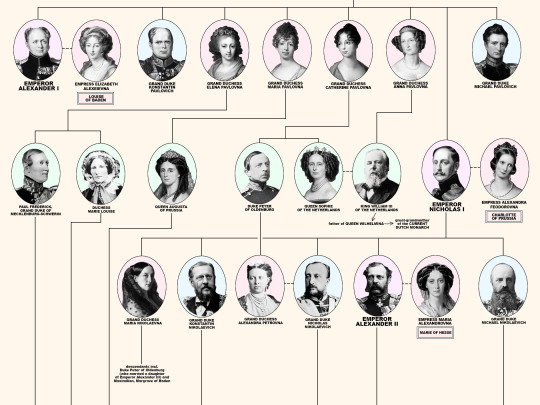
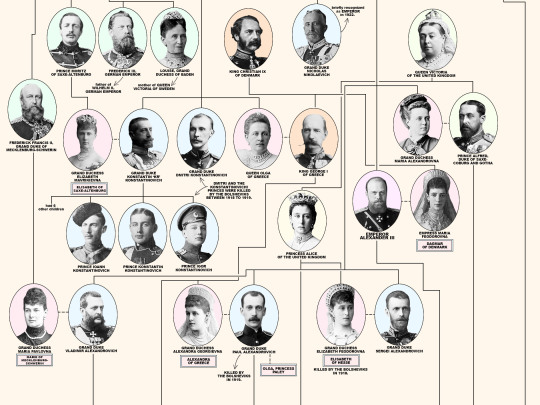
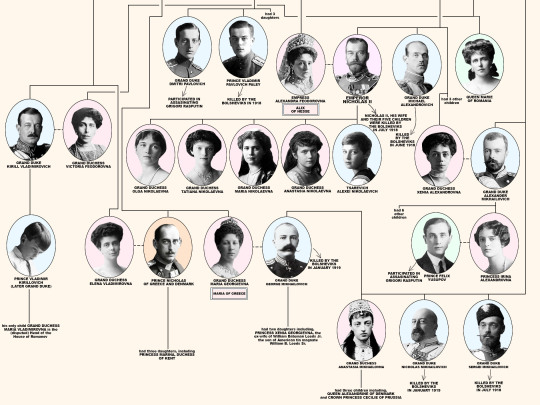
Members of the House of Romanov, the last reigning Dynasty of Russia.
From the first Romanov Russian Tsar Michael I (reigned 1613-1645) until the last Emperor Nicholas II (reigned 1894-1917). Including the 18 members of the house executed from 1918 until 1919; Grand Duke Michael Alexandrovich (13 June 1918). Nicholas II, Empress Alexandra Feodorovna, Grand Duchesses Olga Nikolaevna, Tatiana Nikolaevna, Maria Nikolaevna, Anastasia Nikolaevna, and Tsarevich Alexei Nikolaevich (17 July 1918). Grand Duchess Elizabeth Feodorovna, Grand Duke Sergei Mikhailovich, Prince Ioann Konstantinovich, Prince Konstantin Konstantinovich, Prince Igor Konstantinovich, and Prince Vladimir Paley (18 July 1918). Grand Duke Paul Alexandrovich, Grand Duke Dmitri Konstantinovich, Grand Duke Nicholas Mikhailovich, and Grand Duke George Mikhailovich (28 January 1919).
#romanovs#history#nicholas ii#alexandra feodorovna#olga nikolaevna#tatiana nikolaevna#maria nikolaevna#anastasia nikolaevna#alexei nikolaevich#myedits#peter i#peter ii#Peter iii#peter iii#Catherine the great#tsar alexei i#tsar michael#tsar paul i#alexander i#alexander ii#alexander iii#nicholas i#ancestry
414 notes
·
View notes
Text
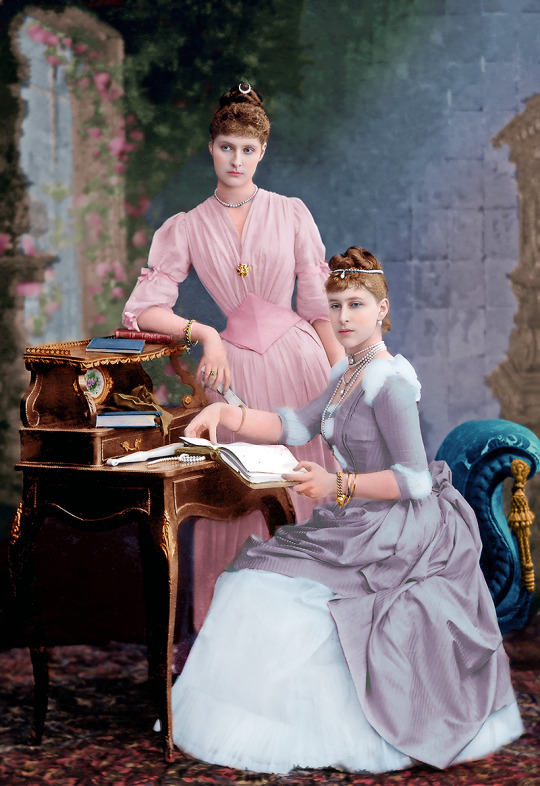
Princess Alix of Hesse (later Empress Alexandra Feodorovna of Russia) with her sister Grand Duchess Elizabeth Feodorovna of Russia, 1890.
#Princess Alix of Hesse#Princess Elizabeth of Hesse#empress alexandra feodorovna#Empress alexandra of russia#Empress alexandra feodorovna of russia#grand duchess elizabeth#grand duchess elizabeth feodorovna#grand duchess elizabeth feodorovna of russia#1890#1890s#1890s fashion#imperial russia#imperial family#russian imperial family#romanovs#victorian#colored photography#german royals#german royalty#history colored
90 notes
·
View notes
Text
City of Ladies: the game

This post is based on a discussion with @lilias42. The idea was to imagine what an all-women Civilization-like game would look like. Would that be even possible?
This was done for fun, my choice of leaders is in no way a political statement. My goal is to showcase amazing historical ladies. I couldn't include everyone, so some choices were made. Let's go!
Angola: Njinga Mbande
Arabia: Samsi/Al-Khayzuran
Byzantine Empire: Irene of Athens/Theodora the Armenian/Theodora Porphyrogenita/Eudokia Makrembolitissa/Anna Dalassene
Carthage: Elissa-Dido
China: Fu Hao/Queen Dowager Xuan/Wu Zetian/Empress Liu
Celts: Boudica/Cartimandua
Denmark: Margaret I of Denamrk
Egypt: Merneith/Ahhotep I/Hatshepsut
England: Seaxburh of Wessex/Æthelflæd of Mercia/Empress Matilda/Eleanor of Aquitaine/ Elizabeth I
France: Blanche of Castile/ Emma of France/Brunehilda/Fredegund/Anne of France
Georgia: Tamar of Georgia
Germany: Theophanu Skleraina/ Matilda of Quedlinburg
Greece: Laskarina Bouboulina
Inca: Mama Huaco/Chañan Cori Coca
India: Rani Lakshmibai/Rudrama Devi/Didda of Kashmir/Ahilyabai Holkar
Italy: Matilda of Tuscany/Joanna I of Naples/Caterina Sforza/Lucrezia Borgia
Japan: Himiko/Empress Suiko/Empress Jito/Hojo Masako
Korea: Seondeok/Jindeok/Empress Myeongseong
Macedonia: Olympias/Eurydice I of Macedon
Maya: Lady K'abel/Wak Chanil Ajaw/ Lady K’awiil Ajaw
Mongolia: Sorghaghtani Beki/Mandukhai Khatun
Nigeria: Amina of Zaria
Nubia: Amanirenas/Amanitore
Ottoman Empire: Hürrem Sultan/Kösem Sultan
Persia/Iran: Atossa/Boran/Qutlugh Turkhan
Poland: Jadwiga of Poland
Roman Empire: Agrippina the Elder/Julia Domna
Russia: Catherine the Great/Elizabeth of Russia
Scythians/Sarmatians: Tomyris/Sparethra/Amage/Zarinaia
Senegal: Ndaté Yalla Mbodj
South Africa: Mmanthatisi
Spain: Urraca of León and Castile/Isabella I of Castile
United States of America: Harriet Tubman
+indigenous nations and their leaders such as : The Lady of Cofitachequi/ Weetamoo (Wampanoag)/Nonhelema (Shawnee) / Bíawacheeitchish (Apsáalooke)/Pretty Nose (Arapaho)
Vietnam: The Trưng sisters
Yemen: Arwa al-Sulayhi/Asma bint Shihab
19 notes
·
View notes
Text


The Husbands of the Four Graces
Some time ago, I read a very interesting book about Queen Victoria's Hessian Granddaughters (Victoria, Elizabeth, Irene, and Alix.) The title was "The Four Graces," and ever since I read it, that is the way I think about the daughters of Grand Duke of Louis IV of Hesse and by Rhine and the beautiful princess Alice of Saxe-Coburg and Gotha, second daughter of Queen Victoria.
These young women were among the most marriageable princesses of their generation. They were beautiful, accomplished and Queen Victoria's granddaughters. There was no need to look for husbands for them. Among their suitors could be found future Kaisers, Tsars and Kings of England even though it was well known that any or all of the princesses could be carriers of hemophilia (inherited from their august grandmother Victoria.) Their sons might be bleeders. One of their brother's had been, therefore Princess Alice, their mother, had been a carrier.
The four men they married appear in the first photograph above; one marquess, one prince, one grand duke, and one Emperor (all of them very handsome):
👑Louis Mountbatten, first Marques of Milford Heaven (the man all the way to the left on the picture) married Princess Victoria Alberta Elisabeth Mathilde Marie of Hesse and By Rhine. Victoria and Louis had two sons and neither one of them had hemophillia.
👑The Hohenzollern Prince and brother of the German Keiser, Prince Heinrich of Prussia (the man to the right of Mountbatten in the photograph) married Princess Irene Luise Marie Anne of Hesse and By Rhine. They were first cousins since Heinrich was the son of Queen Victoria's eldest daughter, the Princess Royal, who was the older sister of Princess Alice. They had three sons. Two out of the three had hemophilia. One died in childhood of causes related to that disease.
👑 Grand Duke Sergei Alexandrovich of Russia (the man to the right of Prince Heinrich) married Princess Elizabeth Alexandra Louise Alice of Hesse and by Rhine. Sergei and Elizabeth had no children.
👑The soon-to-be Tsar Nicholas II of Russia married Alix Viktoria Helene Luise Beatrix. Alix had one son, and he had hemophilia. (gcl)
#russian history#imperial russia#empress alexandra feodorovna#princess alix of hesse#princess Irene of Hesse#Princess Victoria of Hesse#Princess Elizabeth of Hesse#Tsar Nicholas II#Prince Heinrich of Prussia#Louis Mountbatten#Hessian princesses#hemophilia#gcl
23 notes
·
View notes
Note
do you know where the first few of the romanovs resided before all of the palaces were built and if so, are any of them remaining? do we know what they look like?
I'm afraid very little from the earliest days of the Romanov dynasty had survived the ravages of time. By the time of Nicholas II, many early residences had already been either destroyed or replaced by the modern and elegant palaces we see today. Here's a few that survived.
The Cabin of Peter the Great May 1703
Built during the founding of the city of Saint Petersburg, the log cabin was the first St. Petersburg "palace" of Tsar Peter the Great. The small wooden house was constructed in just three days, by soldiers of the Semyonovskiy Regiment.
At that time, the new St. Petersburg was described as "a heap of villages linked together, like some plantation in the West Indies".
The Cabin was boarded up and camouflaged during the Second World War. It was the first St. Petersburg museum to reopen in September 1944, after the end of the Siege of Leningrad.

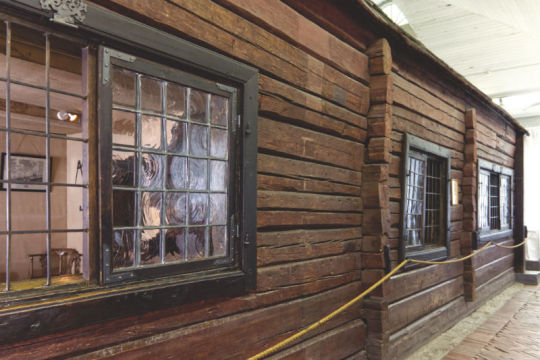
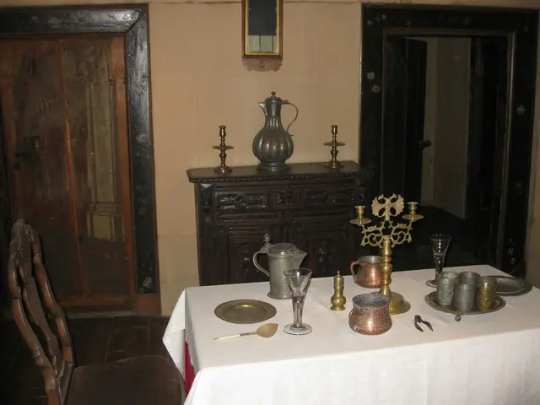
This cabin must have appeared as a huge downgrade after the wooden palace of Tsar Alexei!
The Wooden Palace of Tsar Alexei Romanov 1667
The recreation of an authentic mid-17th century Romanov residence was built recently in 2010. The Palace of Tsar Alexei Mikhailovich, also known as the Wooden Palace of Tsar Alexei, is a large wooden palace in Kolomenskoye, near Moscow, Russia.
The original was built in 1667 without using any fasten materials, nails or hooks. The wooden palace, famed for its fanciful, fairytale roofs, was a summer residence for Russian tsars before St. Petersburg was constructed.
The palace was divided into male and female halves, with the Tsar and Tsarevitches towers and chambers in the male half and the Tsarina's towers in the female half.
The palace's interior featured rich decorations, including carving, painting, gilding, and ceramic tiles, as well as rectangular and round stoves, weathercocks, and windows and porches.



Foreigners referred to this huge maze of intricate corridors and 250 rooms, as 'an Eighth Wonder of the World'. Although basically only a summer palace, it was the favorite residence of Tsar Alexei I.
The future Empress Elizabeth Petrovna was born in the palace in 1709, and Tsar Peter the Great spent part of his youth here.
Upon the departure of the court for the swamps of St. Petersburg, the palace fell into disrepair, so that Catherine the Great refused to make it her Moscow residence. On her orders the wooden palace was demolished in 1768, but thankfully, the detailed plans of the palace had survived.
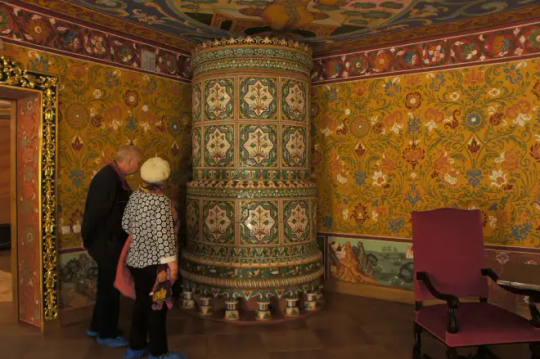
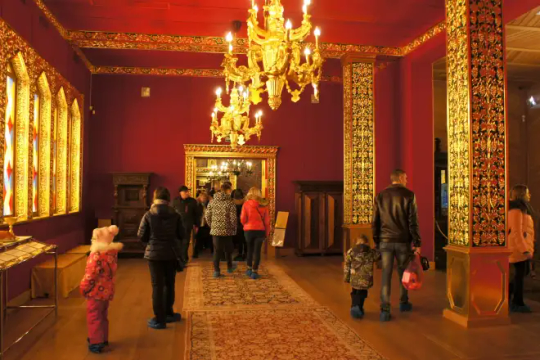
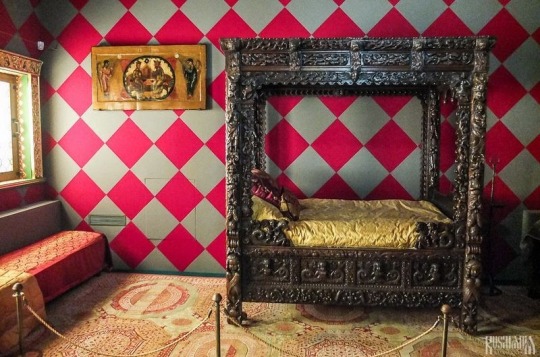



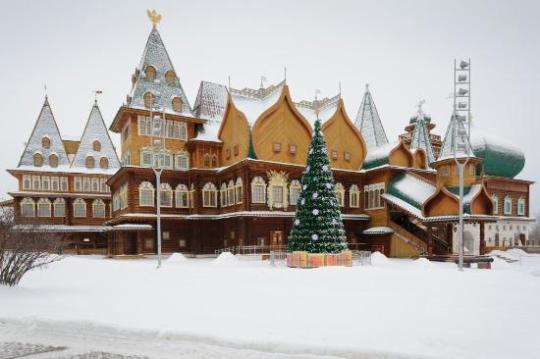
Summer Palace of Peter the Great
1714
One of the earliest imperial residences I can think of that still exists today is the modest Summer Palace of Peter the Great, which is located on an island near the Peter and Paul Fortress, the burial place of the Romanovs.
The palace was built between 1710 and 1714, a few years before the proclamation of the Russian Empire. By the time of Tsar Nicholas II's reign at the end of the 19th century, it became vacant.
During the Second World War, both the Summer Palace and Summer Gardens were badly damaged by a German bombing raid. The building was repaired, however, and the layout remains unchanged from the original.

Above: The palace as depicted in 1809. Below: The residence today.

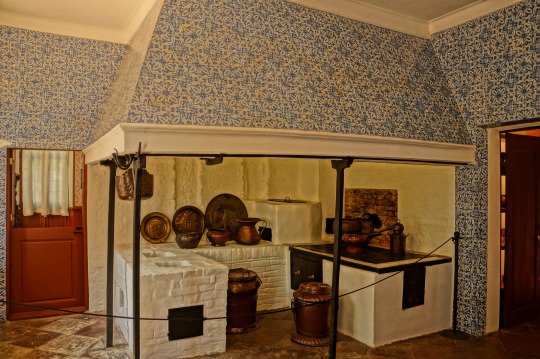

Monplaisir Palace in Peterhof 1714-1716
There is another residence owned by Peter the Great that is still standing today. And that is the Monplaisir Palace in Peterhof.
The following painting depicts the formidable Tsar and his son and heir Tsarevich Alexei Petrovich, who has been accused of preparing to seize power, in the interior of the Monplaisir Palace. Before pronouncing sentence, Peter I gazes into his son's eyes, still hoping to discern signs of remorse.


Above: The Parade Hall of Monplaisir Palace today.



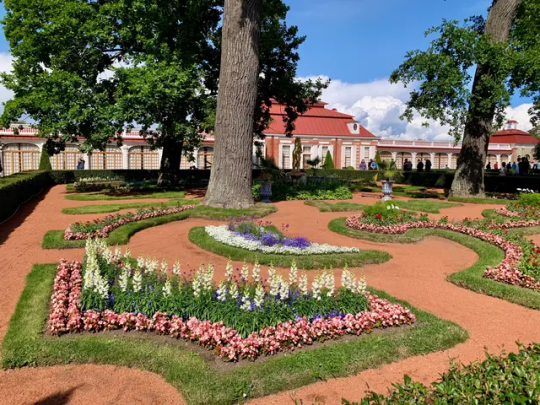
#romanov#romanovs#palace#palaces#history#russian culture#russian history#royal history#imperial russia#moscow#saint petersburg#peterhof#russian imperial family#ask
42 notes
·
View notes
